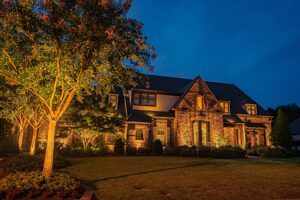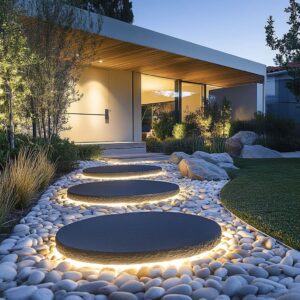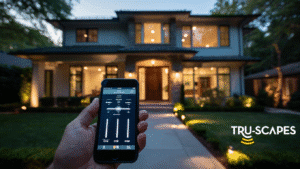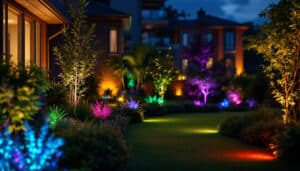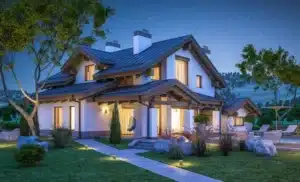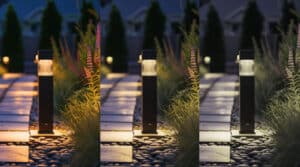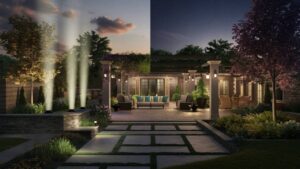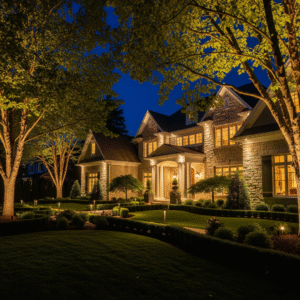Does the thought of your outdoor lighting racking up a high energy bill or negatively impacting the environment dim your enthusiasm for a beautifully lit home? You’re not alone. Many homeowners want to enhance their home’s security and beauty after dark, but also want to make responsible, sustainable choices. The great news is, you don’t have to choose between a stunning landscape and an eco-conscious one.
This guide will show you how to achieve brilliant results with eco-friendly landscape lighting. You’ll learn the best practices for sustainable design and discover which energy-efficient products deliver long-lasting beauty without the environmental baggage. Let’s get started on creating an outdoor space you can be proud of, day and night.
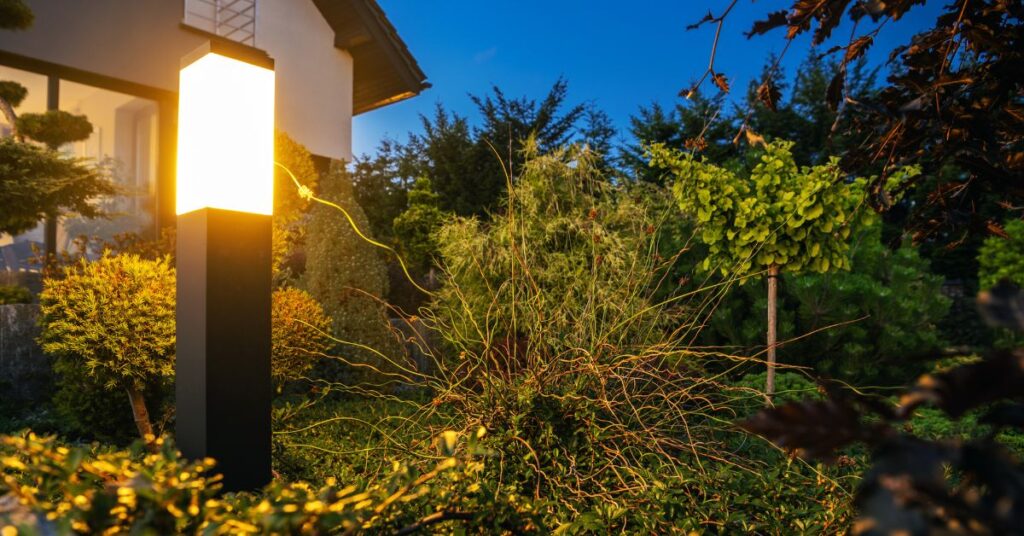
The “Why” Behind Sustainable Outdoor Lighting
Making the switch to eco-friendly lighting isn’t just about feeling good; it’s a practical decision with tangible benefits. When you choose sustainability, you’re also choosing efficiency and quality.
First, there’s the significant drop in energy consumption. This works for your wallet and the planet. Lower energy use means lower electricity bills each month and a smaller carbon footprint over time. Second, truly sustainable products are built to last. This means less manufacturing, less shipping, and less waste ending up in landfills. It’s a smarter investment that pays off for years.
Finally, a well-designed, eco-friendly system respects the natural world. It illuminates your home beautifully while being a good neighbor to local wildlife and the night sky.
The Champion of Efficiency: Low-Voltage LED Lighting
When it comes to sustainable outdoor lighting, there is one clear winner: low-voltage LED systems. The technology has evolved so much that it has become the gold standard for professional landscape designers, and for good reason.
LED stands for “Light Emitting Diode.” A key difference between LEDs and traditional halogen bulbs is that the older types create light by heating a fragile filament, while LEDs use a semiconductor to convert electricity directly into light. This process is incredibly efficient and durable.
This works because very little energy is wasted as heat. A traditional halogen bulb might lose up to 90% of its energy as heat, while an LED light loses only about 5-10%. This efficiency is the core of its eco-friendly power.
Let’s compare them directly.
| Feature | Low-Voltage LED Lighting | Traditional Halogen/Incandescent |
| Energy Usage | Uses up to 80% less energy. | Very high energy consumption. |
| Lifespan | 40,000+ hours. | 1,000 – 2,000 hours. |
| Heat Output | Cool to the touch. | Extremely hot, a potential fire hazard. |
| Durability | Solid-state construction, very durable. | Fragile filament, easily broken. |
| Replacement Waste | Replaced once every 10-15 years. | Frequent replacements create more waste. |
As you can see, the advantages are clear. Investing in a professional-grade, low-voltage LED system means you get superior performance and peace of mind.
Best Practices: It’s Not Just What You Use, It’s How You Use It
Having the right energy-efficient products is only half the battle. A truly sustainable lighting plan comes from a smart design plan. Here are the core practices to follow.
1. Use Only as Much Light as Needed
The goal of landscape lighting is not to replicate daylight. It’s to create ambiance, improve safety, and highlight your home’s best features. Over-lighting is wasteful and can ruin the sophisticated effect you’re after.
Focus on targeted illumination. A single, well-placed uplight can transform a tree from a dark shape into a dramatic focal point. A few path lights can guide guests safely without washing out the entire walkway. This “less is more” approach saves energy and looks far more professional.
2. Direct Light with Purpose
Where your light goes is just as important as how bright it is. Light that spills sideways or shoots up into the sky is wasted. This contributes to two problems:
- Light Trespass: Annoying your neighbors by shining light into their windows.
- Skyglow: The brightening of the night sky over inhabited areas, which obscures the stars and disrupts the cycles of nocturnal wildlife.
The solution is simple: use high-quality fixtures with built-in shields or adjustable heads. Point lights downward whenever possible, especially for paths and patios. When highlighting a wall or tree, aim the fixture carefully so the light stays on the intended target. According to DarkSky International, using shielded fixtures is a key step in reducing light pollution.
3. Choose a Warmer Color Temperature
Light isn’t just one color. It exists on a spectrum from warm (more yellow/amber) to cool (more blue/white). This is measured in Kelvin (K). For outdoor spaces, a warmer color temperature between 2700K and 3000K is ideal.
This warmer light has two main benefits. First, it creates a cozy, welcoming atmosphere that is far more inviting than harsh, cool light. Second, research has shown that blue-rich, cool light is more disruptive to the sleep cycles of humans and the behavior of wildlife. A warm glow is a more natural and responsible choice.
4. Automate with Timers
The most energy-efficient light is one that’s turned off when it’s not needed. Manually flipping a switch is unreliable. The best way to manage your system is with an automated timer.
Modern transformers for low-voltage systems come equipped with astronomical timers and photocells. You can set them to turn on at dusk and turn off at a specific time—say, midnight, when you’re no longer enjoying the view. The photocell ensures the system only runs when it’s dark, automatically adjusting for the changing seasons. This simple tool ensures you’re never wasting energy by lighting an empty yard.
Frequently Asked Questions About Sustainable Lighting
Q: Is LED landscape lighting really that much better for the environment?
A: Yes. The U.S. Department of Energy estimates that widespread use of LEDs could save the equivalent annual electrical output of 44 large electric power plants by 2027. Their long lifespan also dramatically reduces waste from discarded bulbs.
Q: How much money can I save with energy-efficient outdoor lighting?
A: By using up to 80% less electricity than halogen systems, the savings on your utility bill are significant over the life of the system. While the initial investment in professional-grade products may be higher, the lower operating costs and extreme durability provide a superior return on investment. Choosing ENERGY STAR certified products is another great way to ensure quality and long-term savings.
Q: What materials are best for sustainable outdoor lighting fixtures?
A: Look for fixtures made from durable, corrosion-resistant materials like brass, copper, or powder-coated aluminum. These materials stand up to the elements for decades, meaning you won’t have to replace them. They are also recyclable at the end of their very long life.
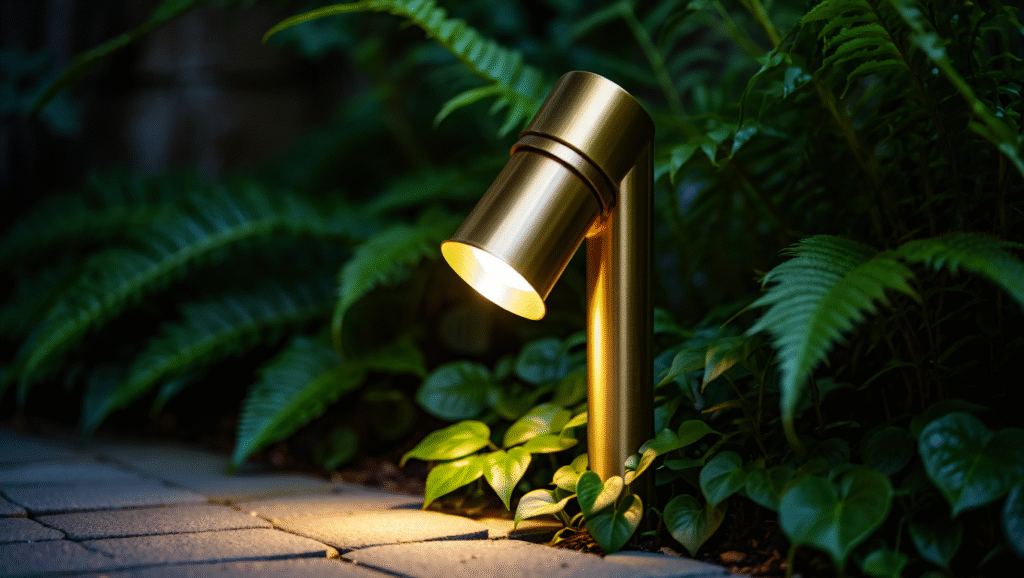
Illuminate Your World, Responsibly
Creating a beautiful and eco-friendly landscape lighting system is entirely within your reach. It starts with choosing the undisputed champion of efficiency: a high-quality, low-voltage LED system. From there, it’s about smart design—using light with intention, directing it carefully, choosing a warm and welcoming color, and automating your system with timers.
By following these best practices, you create a win-win scenario. You get a breathtakingly beautiful outdoor space that enhances your home’s value and your enjoyment of it, all while lowering your energy bills and being a steward of the environment.
Take a look at your own outdoor space tonight. What key features could you highlight? How could a few well-placed, energy-efficient lights transform your yard? We hope this guide inspires you to explore the possibilities. What are your favorite tips for sustainable living at home? Share your thoughts in the comments below!

